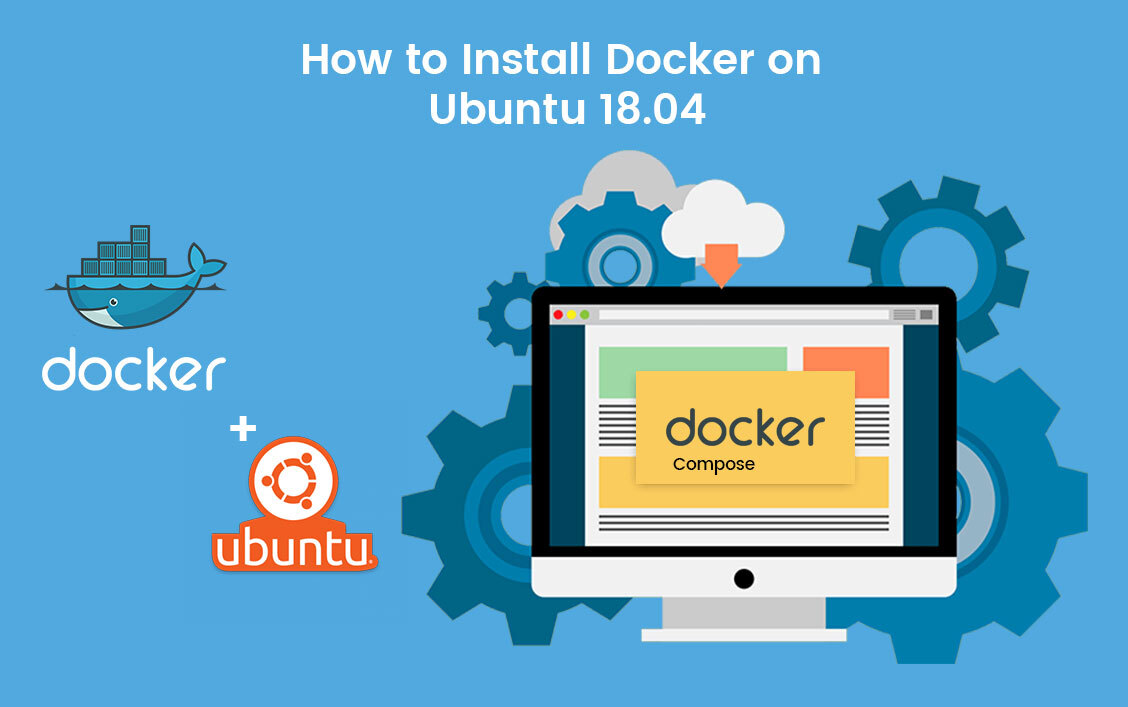Reading Time: 6 mins.
Introduction
Docker, an open-source container-based technology, aims to streamline and manage workload via distributed applications. In simplest form, it’s just another form of Virtualization and the difference lies in the fact that Docker outranks the benefits of the traditional Virtualization almost in every aspect. Further, with the portable and immutable Docker images you can create a Docker container which in turn works in executing the application.
To persist data (to share and save), you have the option of Docker volumes that solely aids the back-up process.The Docker service comes in both free (community) and premium (enterprise) tiers. Want to know more about Docker and does it works, go to the following blog article on A Brief Introduction to Docker and Its Terminologies
Prerequisites
- Ubuntu 18.04 set up with sudo user (non-root) privileges and firewall configuration.
- A Docker Hub account (either public or private) to push/pull images to the Docker Hub.
Let’s Start with Docker Installation
Step: 1
In case, if you have any older versions of Docker, don’t forget to uninstall it first.
To do so, use the below command,
sudo apt-get remove docker docker-engine docker.io
Update your system using the following command:
sudo apt update
Next, add the GPG key to your system.
sudo apt install apt-transport-https ca-certificates curl software-properties-common curl -fsSL https://download.docker.com/linux/ubuntu/gpg | sudo apt-key add -
Add the Docker repository to APT sources to install them:
sudo add-apt-repository "deb [arch=amd64] https://download.docker.com/linux/ubuntu bionic stable"
We have to update the system using the following command so as to update the newly added repositories.
sudo apt update
Make sure you that you install from the Docker repo and not from the default Ubuntu repo:
apt-cache policy docker-ce
You’ll see an output like below but the Docker’s version number may be different for you:
Output:
docker-ce: Installed: (none) Candidate: 18.03.1~ce~3-0~ubuntu Version table: 18.03.1~ce~3-0~ubuntu 500 500 https://download.docker.com/linux/ubuntu bionic/stable amd64 Packages
Notice that docker-ce is not installed, but the candidate for installation is from the Docker repository for Ubuntu 18.04 (bionic).
After removing the older version, install Docker and Docker-compose using the following commands.
sudo apt install docker-ce
Follow the below step for docker-compose,
Check the current release, and if necessary, update it using the command below:
sudo curl -L https://github.com/docker/compose/releases/download/1.21.2/docker-compose-`uname -s`-`uname -m` -o /usr/local/bin/docker-compose
Next, set the permissions:
sudo chmod +x /usr/local/bin/docker-compose
Now, it’s time to confirm the successful installation via version check.
sudo docker-compose --version
Output
docker-compose version 1.21.2, build a133471
Note: If you want to install the specific version of Docker, visit the following link
https://download.docker.com/linux/ubuntu/dists/bionic/pool/stable/amd64/
Step: 2
Checking Docker Status
To check whether the Docker is up and running using the following command.
sudo service docker status
Output
● docker.service - Docker Application Container Engine
Loaded: loaded (/lib/systemd/system/docker.service; enabled; vendor preset: enabled)
Active: active (running) since Fri 2020-07-31 10:13:26 IST; 4min 3s ago
TriggeredBy: ● docker.socket
Docs: https://docs.docker.com
Main PID: 1751 (dockerd)
Tasks: 13
Memory: 132.3M
CGroup: /system.slice/docker.service
└─1751 /usr/bin/dockerd -H fd:// --containerd=/run/containerd/containerd.sock
Jul 31 10:13:25 demo@user dockerd[1751]: time="2020-07-31T10:13:25.418272415+05:30" level=warning msg="Your kernel does not support cgroup rt runtime"
Jul 31 10:13:25 demo@user dockerd[1751]: time="2020-07-31T10:13:25.418298375+05:30" level=warning msg="Your kernel does not support cgroup blkio weight"
Jul 31 10:13:25 demo@user dockerd[1751]: time="2020-07-31T10:13:25.418322096+05:30" level=warning msg="Your kernel does not support cgroup blkio weight_device"
Jul 31 10:13:25 demo@user dockerd[1751]: time="2020-07-31T10:13:25.418745549+05:30" level=info msg="Loading containers: start."
Jul 31 10:13:26 demo@user dockerd[1751]: time="2020-07-31T10:13:26.047719198+05:30" level=info msg="Default bridge (docker0) is assigned with an IP address 172.17.0.0/16. >
Jul 31 10:13:26 demo@user dockerd[1751]: time="2020-07-31T10:13:26.115412731+05:30" level=info msg="Loading containers: done."
Jul 31 10:13:26 demo@user dockerd[1751]: time="2020-07-31T10:13:26.220296591+05:30" level=info msg="Docker daemon" commit=48a66213fe graphdriver(s)=overlay2 version=19.03.>
Jul 31 10:13:26 demo@user dockerd[1751]: time="2020-07-31T10:13:26.221000688+05:30" level=info msg="Daemon has completed initialization"
Jul 31 10:13:26 demo@user dockerd[1751]: time="2020-07-31T10:13:26.256756632+05:30" level=info msg="API listen on /run/docker.sock"
Jul 31 10:13:26 demo@user systemd[1]: Started Docker Application Container Engine.
Automate Docker
The Docker service needs to be set up to run at startup. To do so, type in each command followed by an enter:
sudo systemctl start docker
sudo systemctl enable docker
Step: 3
Let’s add docker user to sudo group
If you want to avoid typing sudo whenever you run the docker command, add your username to the docker group:
For reference, let’s add the user called demo to the docker group using the following command:
sudo usermod -aG docker demo
To verify whether the user has been added to the sudo group, type:
su demo
Note: Once we add the user to docker group, we need not to use sudo for every docker command.
Let’s Start working with the Docker Commands
Now that we have seen how to install Docker on Ubuntu 18.04, let’s move forward with when and how do we use the Docker commands to make the desirable configurations and to tweak the other required settings.

Step 1: Applying the Docker Commands
In docker, you are supposed to commit a series of options, commands and arguments as the following syntax.
docker [option] [command] [arguments]
Type docker in order to display all the sub-commands.
docker
The following are the list of sub-commands currently available as of Docker 18.
Output
Usage: docker [OPTIONS] COMMAND
A self-sufficient runtime for containers
Options:
--config string Location of client config files (default "/home/adoldev/.docker")
-c, --context string Name of the context to use to connect to the daemon (overrides DOCKER_HOST env var and default context set with "docker context use")
-D, --debug Enable debug mode
-H, --host list Daemon socket(s) to connect to
-l, --log-level string Set the logging level ("debug"|"info"|"warn"|"error"|"fatal") (default "info")
--tls Use TLS; implied by --tlsverify
--tlscacert string Trust certs signed only by this CA (default "/home/adoldev/.docker/ca.pem")
--tlscert string Path to TLS certificate file (default "/home/adoldev/.docker/cert.pem")
--tlskey string Path to TLS key file (default "/home/adoldev/.docker/key.pem")
--tlsverify Use TLS and verify the remote
-v, --version Print version information and quit
Management Commands:
builder Manage builds
config Manage Docker configs
container Manage containers
context Manage contexts
engine Manage the docker engine
image Manage images
network Manage networks
node Manage Swarm nodes
plugin Manage plugins
secret Manage Docker secrets
service Manage services
stack Manage Docker stacks
swarm Manage Swarm
system Manage Docker
trust Manage trust on Docker images
volume Manage volumes
Commands:
attach Attach local standard input, output, and error streams to a running container
build Build an image from a Dockerfile
commit Create a new image from a container's changes
cp Copy files/folders between a container and the local filesystem
create Create a new container
diff Inspect changes to files or directories on a container's filesystem
events Get real time events from the server
exec Run a command in a running container
export Export a container's filesystem as a tar archive
history Show the history of an image
images List images
import Import the contents from a tarball to create a filesystem image
info Display system-wide information
inspect Return low-level information on Docker objects
kill Kill one or more running containers
load Load an image from a tar archive or STDIN
login Log in to a Docker registry
logout Log out from a Docker registry
logs Fetch the logs of a container
pause Pause all processes within one or more containers
port List port mappings or a specific mapping for the container
ps List containers
pull Pull an image or a repository from a registry
push Push an image or a repository to a registry
rename Rename a container
restart Restart one or more containers
rm Remove one or more containers
rmi Remove one or more images
run Run a command in a new container
save Save one or more images to a tar archive (streamed to STDOUT by default)
search Search the Docker Hub for images
start Start one or more stopped containers
stats Display a live stream of container(s) resource usage statistics
stop Stop one or more running containers
tag Create a tag TARGET_IMAGE that refers to SOURCE_IMAGE
top Display the running processes of a container
unpause Unpause all processes within one or more containers
update Update configuration of one or more containers
version Show the Docker version information
wait Block until one or more containers stop, then print their exit codes
Run 'docker COMMAND --help' for more information on a command.
To showcase the available options to a specific command, enter
docker docker-subcommand --help
In order to view the Docker’s system-wide information, type
docker info
Next, we start by working with simple Docker images. We will know more about these commands later.
Step 2: Managing Docker commands
Next, you will be introduced to the basic docker commands.
To view the list of docker images, type:
docker images -a
To view the list of docker containers, type:
docker ps -a
To remove the docker images, type:
docker image rm image_id
Note: If you find any error while removing the docker images, just pass the -f parameter like below:
docker image rm image_id -f
To remove the single docker container, type:
docker rm container_id or name
To remove all the docker containers, type:
docker stop $(docker ps -a -q) docker rm $(docker ps -a -q)
To remove the docker volumes, type:
docker volume ls docker volume rm volume_id
To remove the docker networks, type:
docker network ls docker network rm network_name
To access the docker container shell, type:
docker exec -it container_name bash
To inspect the docker container ,network or image type:
docker inspect container_name or image_name or network_name
Note: If the access is getting denied, make sure that the container is up and running. If the container is found to be inactive, re-run the container using the command below.
docker start container_id
To view the individual docker container’s IP address, type:
docker inspect --format='{{range .NetworkSettings.Networks}}{{.IPAddress}}{{end}}' 0861188a6c87(container id)
Conclusion
In this article, we have installed Docker on Ubuntu 18.04. Docker, an open-source software aids in streamlining the process of managing and maintaining workloads via distributed applications. To know more about the docker configuration, visit, https://docs.docker.com/get-started/overview. You have also come across the necessary commands that are required to perform the Docker configuration along with defining one such Docker syntax followed by passing the code on your system.

